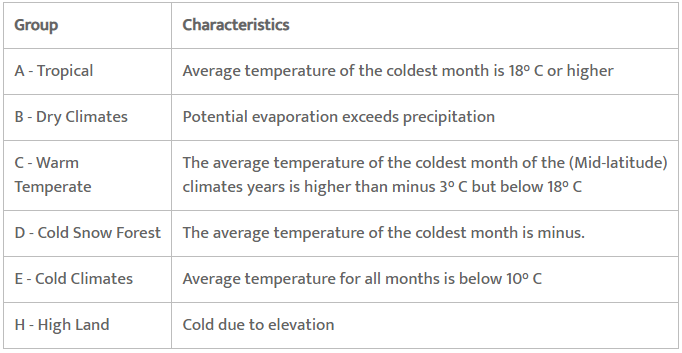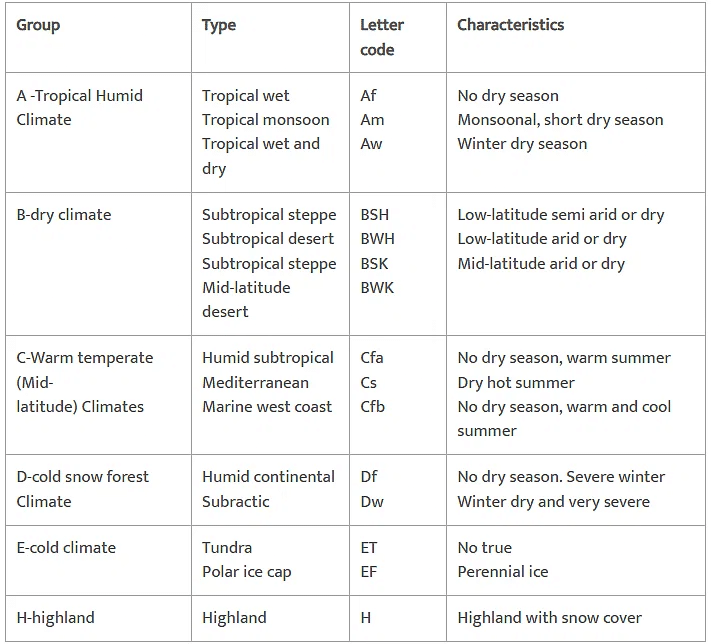World Climate & Climate Change - 1 Class 11 Geography
Introduction
- Three broad approaches have been adopted for classifying climate.
- Empirical classification is based on observed data, particularly on temperature and precipitation.
- Genetic classification attempts to organize climates according to their causes.
- Applied classification is for specific purpose.
Koeppen's Scheme of classification of climate
- The most widely used classification of climate is the empirical climate classification scheme developed by V. Koeppen. Koeppen identified a close relationship between the distribution of vegetation and climate.
- He selected certain values of temperature and precipitation and related them to the distribution of vegetation and used these values for classifying the climates.
- It is an based on mean annual and mean monthly temperature and precipitation data.
- He introduced the use of capital and small letters to designate climatic groups and types
- Koeppen recognised five major climatic groups, four of them are based on temperature and one on precipitation.

- The capital letters : A,C, D and E delineate humid climates and B dry climates.
- The climatic groups are subdivided into types, designated by small letters, based on seasonality of precipitation and temperature characteristics.
- The seasons of dryness are indicated by the small letters : f, m, w and s, where f corresponds to no dry season m - monsoon climate, w- winter dry season and s - summer dry season. The small letters a, b, c and d refer to the degree of severity of temperature. The B- Dry Climates are subdivided using the capital letters S for steppe or semi-arid and W for deserts.

Group A : Tropical Humid Climates
- Tropical humid climates exist between Tropic of Cancer and Tropic of Capricorn.
- The sun being overhead throughout the year and the presence of Inter Tropical Convergence Zone (ITCZ) make the climate hot and humid.
- Annual range of temperature is very low and annual rainfall is high.
- The tropical group is divided into three types, namely
- (i) Af- Tropical wet climate; (ii) Am - Tropical monsoon climate; 3) Aw- Tropical wet and dry climate.
Tropical Wet Climate (Af)
Tropical wet climate is found near the equator. The major areas are the Amazon Basin in South America, western equatorial Africa and the islands of East Indies.
- Significant amount of rainfall occurs in every month of the year as thunder showers in the afternoon.
- The temperature is uniformly high and the annual range of temperature is negligible.
- The maximum temperature on any day is around 30°C while the minimum temperature is around 20°C.
- Tropical evergreen forests with dense canopy cover and large biodiversity are found in this climate.
Tropical Monsoon Climate (Am)
- Tropical monsoon climate (Am) is found over the Indian sub-continent, North Eastern part of South America and Northern Australia.
- Heavy rainfall occurs mostly in summer. Winter is dry.
Tropical Wet and Dry Climate (Aw)
- Tropical wet and dry climate occurs north and south of Af type climate regions.
- It borders with dry climate on the western part of the continent and Cf or Cw on the eastern part. Extensive Aw climate is found to the north and south of the Amazon forest in Brazil and adjoining parts of Bolivia and Paraguay in South America, Sudan and south of Central Africa.
- The annual rainfall in this climate is considerably less than that in Af and Am climate types and is variable also.
- The wet season is shorter and the dry season is longer with the drought being more severe.
- Temperature is high throughout the year and diurnal ranges of temperature are the greatest in the dry season.
- Deciduous forest and tree-shredded grasslands occur in this climate.
Dry Climates : B
- Dry climates are characterised by very low rainfall that is not adequate for the growth of plants.
- These climates cover a very large area of the planet extending over large latitudes from 15° - 60° north and south of the equator.
- At low latitudes, from 15° - 30°, they occur in the area of subtropical high where subsidence and inversion of temperature do not produce rainfall.
- On the western margin of the continents, adjoining the cold current, particularly over the west coast of South America, they extend more equatorwards and occur on the coast land.
- In middle latitudes, from 35° - 60° north and south of equator, they are confined to the interior of continents where maritime-humid winds do not reach and to areas often surrounded by mountains.
- Dry climates are divided into steppe or semi-arid climate (BS) and desert climate (BW). They are further subdivided as subtropical steppe (BSh) and subtropical desert (BWh) at latitudes from 15° - 35° and mid-latitude steppe (BSk) and mid-latitude desert (BWk) at latitudes between 35° - 60°.
Subtropical Steppe (BSh) and Subtropical Desert (BWh) Climates
- Subtropical steppe (BSh) and subtropical desert (BWh) have common precipitation and temperature characteristics.
- Located in the transition zone between humid and dry climates, subtropical steppe receives slightly more rainfall than the desert, adequate enough for the growth of sparse grasslands. The rainfall in both the climates is highly variable.
- The variability in the rainfall affects the life in the steppe much more than in the desert, more often causing famine.
- Rain occurs in short intense thundershowers in deserts and is ineffective in building soil moisture.
- Fog is common in coastal deserts bordering cold currents.
- Maximum temperature in the summer is very high. The highest shade temperature of 58° C was recorded at Al Aziziyah, Libya on 13 September 1922. The annual and diurnal ranges of temperature are also high.
Warm Temperate (Mid-Latitude) Climates-C
- Warm temperate (mid-latitude) climates extend from 30° - 50° of latitude mainly on the eastern and western margins of continents. These climates generally have warm summers with mild winters. They are grouped into four types:
(i) Humid subtropical, i.e. dry in winter and hot in summer (Cwa);
(ii) Mediterranean (Cs);
(iii) Humid subtropical, i.e. no dry season and mild winter (Cfa);
(iv) Marine west coast climate (Cfb).
Humid Subtropical Climate (Cwa)
- Humid subtropical climate occurs pole ward of Tropic of Cancer and Capricorn, mainly in North Indian plains and South China interior plains. The climate is similar to Aw climate except that the temperature in winter is warm.
|
70 videos|340 docs|53 tests
|
FAQs on World Climate & Climate Change - 1 Class 11 Geography
| 1. What are tropical humid climates? |  |
| 2. What are the main features of tropical humid climates? |  |
| 3. How does climate change affect tropical humid climates? |  |
| 4. What are the consequences of deforestation in tropical humid climates? |  |
| 5. How can we mitigate the impacts of climate change on tropical humid climates? |  |






















